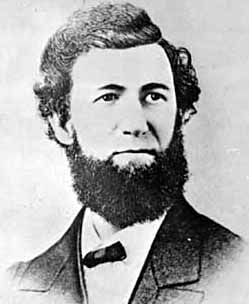
The Underground Railroad was used by freedom seekers from slavery in the United States and was generally an organized network of secret routes and safe houses. Enslaved Africans and African Americans escaped from slavery as early as the 16th century and many of their escapes were unaided, but the network of safe houses operated by agents generally known as the Underground Railroad began to organize in the 1780s among Abolitionist Societies in the North. It ran north and grew steadily until the Emancipation Proclamation was signed in 1863 by President Abraham Lincoln. The escapees sought primarily to escape into free states, and from there to Canada.

William Still was an African-American abolitionist based in Philadelphia, Pennsylvania. He was a conductor of the Underground Railroad and was responsible for aiding and assisting at least 649 slaves to freedom. Still was also a businessman, writer, historian and civil rights activist. Before the American Civil War, Still was chairman of the Vigilance Committee of the Pennsylvania Anti-Slavery Society, named the Vigilant Association of Philadelphia. He directly aided fugitive slaves and also kept records of the people served in order to help families reunite.

The Fugitive Slave Act or Fugitive Slave Law was a law passed by the 31st United States Congress on September 18, 1850, as part of the Compromise of 1850 between Southern interests in slavery and Northern Free-Soilers.

Levi Coffin Jr. was an American Quaker, Republican, abolitionist, farmer, businessman and humanitarian. An active leader of the Underground Railroad in Indiana and Ohio, some unofficially called Coffin the "President of the Underground Railroad", estimating that three thousand fugitive slaves passed through his care. The Coffin home in Fountain City, Wayne County, Indiana, is a museum, sometimes called the Underground Railroad's "Grand Central Station".

In the United States, fugitive slaves or runaway slaves were terms used in the 18th and 19th centuries to describe people who fled slavery. The term also refers to the federal Fugitive Slave Acts of 1793 and 1850. Such people are also called freedom seekers to avoid implying that the enslaved person had committed a crime and that the slaveholder was the injured party.

Joshua Glover was a fugitive slave who escaped from the United States to Canada in the 1850s. His escape from recapture was part of the chain of events that led to the Civil War and the end of slavery in the U.S.

Lewis Hayden escaped slavery in Kentucky with his family and reached Canada. He established a school for African Americans before moving to Boston, Massachusetts. There he became an abolitionist, lecturer, businessman, and politician. Before the American Civil War, he and his wife Harriet Hayden aided numerous fugitive slaves on the Underground Railroad, often sheltering them at their house.

Songs of the Underground Railroad were spiritual and work songs used during the early-to-mid 19th century in the United States to encourage and convey coded information to escaping slaves as they moved along the various Underground Railroad routes. As it was illegal in most slave states to teach slaves to read or write, songs were used to communicate messages and directions about when, where, and how to escape, and warned of dangers and obstacles along the route.

The pre-American Civil War practice of kidnapping into slavery in the United States occurred in both free and slave states, and both fugitive slaves and free negroes were transported to slave markets and sold, often multiple times. There were also rewards for the return of fugitives. Three types of kidnapping methods were employed: physical abduction, inveiglement of free blacks, and apprehension of fugitives. The enslavement, or re-enslavement, of free blacks occurred for 85 years, from 1780 to 1865. Kidnapping of black children for resale was a consistent issue throughout the slavery period.

"Darling Nelly Gray" is a 19th century anti-slavery ballad written and composed by Benjamin Hanby in 1856. It is written as from the point of view of an African-American male slave in Kentucky whose sweetheart has been taken away by slave-owners. The man mourns his beloved, who has been sold South to Georgia. He eventually dies and joins her in heaven. The song became popular in the years preceding the Civil War and helped promote support for the abolitionist cause.

Henry Walton Bibb, was an American author and abolitionist who was born into slavery. Bibb told his life story in his Narrative of the Life and Adventures of Henry Bibb, An American Slave, which included many failed escape attempts followed finally by success when he escaped to Detroit. After leaving Detroit to move to Canada with his family, due to issues with the legality of his assistance in the Underground Railroad, he founded the abolitionist newspaper, Voice of the Fugitive. He lived in Canada until his death.
Africa is an unincorporated community located in Orange Township of southern Delaware County, Ohio, United States, by Alum Creek. It is not the only town named after the underground railroad. There is also Getaway, Ohio located in Lawrence County.
Thomas James (1804–1891) had been a slave who became an African Methodist Episcopal Zion minister, abolitionist, administrator and author. He was active in New York and Massachusetts with abolitionists, and served with the American Missionary Association and the Union Army during the American Civil War to supervise the contraband camp in Louisville, Kentucky. After the war, he held national offices in the AME Church and was a missionary to black churches in Ohio. While in Massachusetts, he challenged the railroad's custom of forcing blacks into second-class carriages and won a reversal of the rule in the State Supreme Court. He wrote a short memoir published in 1886.

The Underground Railroad in Indiana was part of a larger, unofficial, and loosely-connected network of groups and individuals who aided and facilitated the escape of runaway slaves from the southern United States. The network in Indiana gradually evolved in the 1830s and 1840s, reached its peak during the 1850s, and continued until slavery was abolished throughout the United States at the end of the American Civil War in 1865. It is not known how many fugitive slaves escaped through Indiana on their journey to Michigan and Canada. An unknown number of Indiana's abolitionists, anti-slavery advocates, and people of color, as well as Quakers and other religious groups illegally operated stations along the network. Some of the network's operatives have been identified, including Levi Coffin, the best-known of Indiana's Underground Railroad leaders. In addition to shelter, network agents provided food, guidance, and, in some cases, transportation to aid the runaways.
William Parker was an American former slave who escaped from Maryland to Pennsylvania, where he became an abolitionist and anti-slavery activist in Christiana. He was a farmer and led a black self-defense organization. He was notable as a principal figure in the Christiana incident, 1851, also known as the Christiana Resistance. Edward Gorsuch, a Maryland slaveowner who owned four slaves who had fled over the state border to Parker's farm, was killed and other white men in the party to capture the fugitives were wounded. The events brought national attention to the challenges of enforcing the Fugitive Slave Law of 1850.
George DeBaptiste was a prominent African-American conductor on the Underground Railroad in southern Indiana and Detroit, Michigan. Born free in Virginia, he moved as a young man to the free state of Indiana. In 1840, he served as valet and then White House steward for US President William Henry Harrison, who was from that state. In the 1830s and 1840s DeBaptiste was an active conductor on the underground railroad in Madison, Indiana. Located along the Ohio River across from Kentucky, a slave state, this town was a destination for refugee slaves seeking escape from slavery.

William Lambert was a prominent African-American citizen and abolitionist in Detroit during the mid to late 19th century. With a formal education and a background in the anti-slavery movement from a young age he would become a significant figure in Detroit's local black community and the city at large for over 50 years. In the late 1840s Lambert's actions in helping a fugitive slave's escape into Canada from Detroit would play a part in the passage of the Fugitive Slave Act in 1850.
Indian Run is a populated place in Wilmington Township of Mercer County, Pennsylvania, named for the stream Indian Run. Indian Run had a reputation as a "safe haven" for African Americans, whether they were free or escaping slavery. Abolitionists who broke away from a New Wilmington church established the White Chapel Church. In the 1840s, a settlement was created for freedmen called Pandenarium. John Young and others were prominent Underground Railroad conductors.

The Tilly Escape occurred in October 1856 when an enslaved woman, Tilly, was led by Harriet Tubman from slavery in Baltimore to safety in Philadelphia. Historians who have studied Tubman consider it "one of her most complicated and clever escape attempts." It was a risky trip because Tubman and Tilly would not have been able to travel directly from Baltimore to Philadelphia without proof that they were free women. In addition, local slave traders would have recognized strangers. Tubman sought to evade capture by going south, before heading north, and using different modes of transportation over water and land.
Kentucky raid in Cass County (1847) was conducted by slaveholders and slave catchers who raided Underground Railroad stations in Cass County, Michigan to capture black people and return them to slavery. After unsuccessful attempts, and a lost court case, the Fugitive Slave Act of 1850 was enacted. Michigan's Personal Liberty Act of 1855 was passed in the state legislature to prevent the capture of formerly enslaved people that would return them to slavery.













